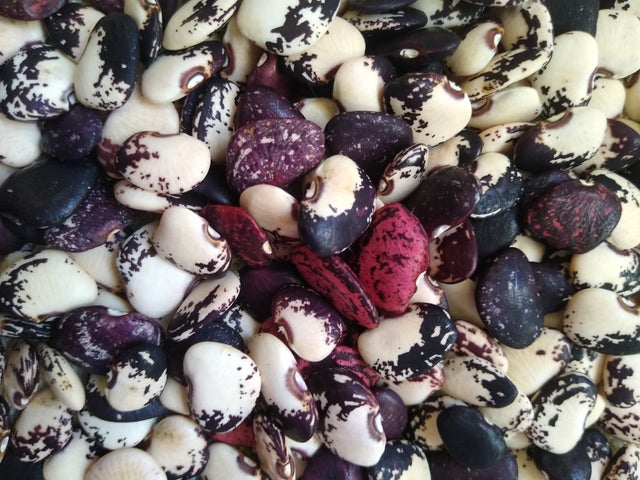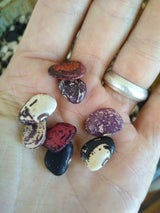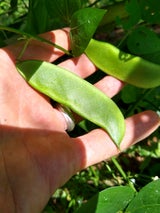- Beans
- >
- Lindsey Butterbeans
Lindsey Butterbeans
SKU:
LindseyBB20
$10.00
$10.00
Unavailable
per item
Species: Phaseolus Lunatus
Sold out
The Story: Some years ago I attended a seed swap in Winston-Salem where I learned an unfortunate lesson about the perils of taking your whole seed collection to a swap. On the positive side, I came across a little bag of "Lindsey Beans" laying in the company of a number of other old heirlooms with handwritten labels like "Granny's Summer Squash." Unfortunately the seed-share-er had already left the event (I always prefer to meet and talk to people about their seeds), but tucked into each bag was a business card for a Cindy Barlowe. I reached out to her, and I sent her some Greasy beans through the mail in thanks. In turn she sent back some wonderful old heirlooms that I'm still growing out!
My favorite might be these butterbeans from Cindy, which are a mix of old time beans from a family in Connelly Springs, NC (white with brown or black speckles), and "Ted's Beans" that Cindy received from an older Avery County man. Since they were already mixed, I added a solitary black butterbean I found in a mix of Cherokee Soup beans. It just felt like the right thing to do at the time, and I don't regret it!
Species: Phaseolus Lunatus
Growing Notes: Lindsey beans are "pole habit" (great as cornfield beans), unlike a lot of other lima beans on the market. They are also small, and therefore have a different texture than a big typical lima. Most pests are disinterested in butterbeans, as the hull is toxic (just eat the seeds cooked, DON'T EAT THE PODS, OR GIVE THEM TO LIVESTOCK). I like to plant my butterbeans to serve as a pollination barrier between different varieties of common beans (Phaseolus Vulgaris greasy beans, pink-tips, cornfield beans etc.) Sometimes I mix butterbeans (both species) in with a species of common bean (usually a soup mix), confident that the three species will not cross.
Bean Communities: Genetic diversity is the key to crops that are resilient to the wide range of diseases, harmful insects, and unpredictable weather extremes brought on by a rapidly changing climate. Bean Communities are essentially generations upon generations of mixed beans, sometimes of multiple species, not just varieties. They hold a deep well of genetic diversity. Often you can carefully try to select for a particular seed color or other trait, only to find that the next generation you plant comes back in a wide-range of colors and shapes. It is truly magical to see what new colors and patterns emerge each year. Many old, old bean seeds traced back to the Cherokee and other native peoples in the mountains were raised as bean communities.
Seed-saving: All Phaseolus species commonly grown in the garden are self-fertile, and the seeds can be easily saved with only minor care to isolation distances. I usually pull the pods as soon as they begin to turn yellow and let the pod finish drying inside before popping them open. I would recommend saving and planting an equal proportion of colors and patterns, but if a certain one strikes your fancy, or you find that one bean is drastically outperforming the rest, you could consider only saving those seeds and working towards creating your own variety.
The Two Butterbeans:
There are two different species of garden bean that are sometimes referred to as butterbeans: Phaseolus coccineus (Runner Beans) and Phaseolus Lunatus (Lima Beans). In the piedmont and coastal plain when you hear "butterbean", generally people are referring to Lima beans, but up in the mountains, it's usually Coccineus, which is a large-seeded bean that prefers cooler weather, creates big show-stopping bloom clusters, and climbs like crazy. Many have heard of "Scarlett Runner Beans," which are a type of Coccineus.
My favorite might be these butterbeans from Cindy, which are a mix of old time beans from a family in Connelly Springs, NC (white with brown or black speckles), and "Ted's Beans" that Cindy received from an older Avery County man. Since they were already mixed, I added a solitary black butterbean I found in a mix of Cherokee Soup beans. It just felt like the right thing to do at the time, and I don't regret it!
Species: Phaseolus Lunatus
Growing Notes: Lindsey beans are "pole habit" (great as cornfield beans), unlike a lot of other lima beans on the market. They are also small, and therefore have a different texture than a big typical lima. Most pests are disinterested in butterbeans, as the hull is toxic (just eat the seeds cooked, DON'T EAT THE PODS, OR GIVE THEM TO LIVESTOCK). I like to plant my butterbeans to serve as a pollination barrier between different varieties of common beans (Phaseolus Vulgaris greasy beans, pink-tips, cornfield beans etc.) Sometimes I mix butterbeans (both species) in with a species of common bean (usually a soup mix), confident that the three species will not cross.
Bean Communities: Genetic diversity is the key to crops that are resilient to the wide range of diseases, harmful insects, and unpredictable weather extremes brought on by a rapidly changing climate. Bean Communities are essentially generations upon generations of mixed beans, sometimes of multiple species, not just varieties. They hold a deep well of genetic diversity. Often you can carefully try to select for a particular seed color or other trait, only to find that the next generation you plant comes back in a wide-range of colors and shapes. It is truly magical to see what new colors and patterns emerge each year. Many old, old bean seeds traced back to the Cherokee and other native peoples in the mountains were raised as bean communities.
Seed-saving: All Phaseolus species commonly grown in the garden are self-fertile, and the seeds can be easily saved with only minor care to isolation distances. I usually pull the pods as soon as they begin to turn yellow and let the pod finish drying inside before popping them open. I would recommend saving and planting an equal proportion of colors and patterns, but if a certain one strikes your fancy, or you find that one bean is drastically outperforming the rest, you could consider only saving those seeds and working towards creating your own variety.
The Two Butterbeans:
There are two different species of garden bean that are sometimes referred to as butterbeans: Phaseolus coccineus (Runner Beans) and Phaseolus Lunatus (Lima Beans). In the piedmont and coastal plain when you hear "butterbean", generally people are referring to Lima beans, but up in the mountains, it's usually Coccineus, which is a large-seeded bean that prefers cooler weather, creates big show-stopping bloom clusters, and climbs like crazy. Many have heard of "Scarlett Runner Beans," which are a type of Coccineus.



